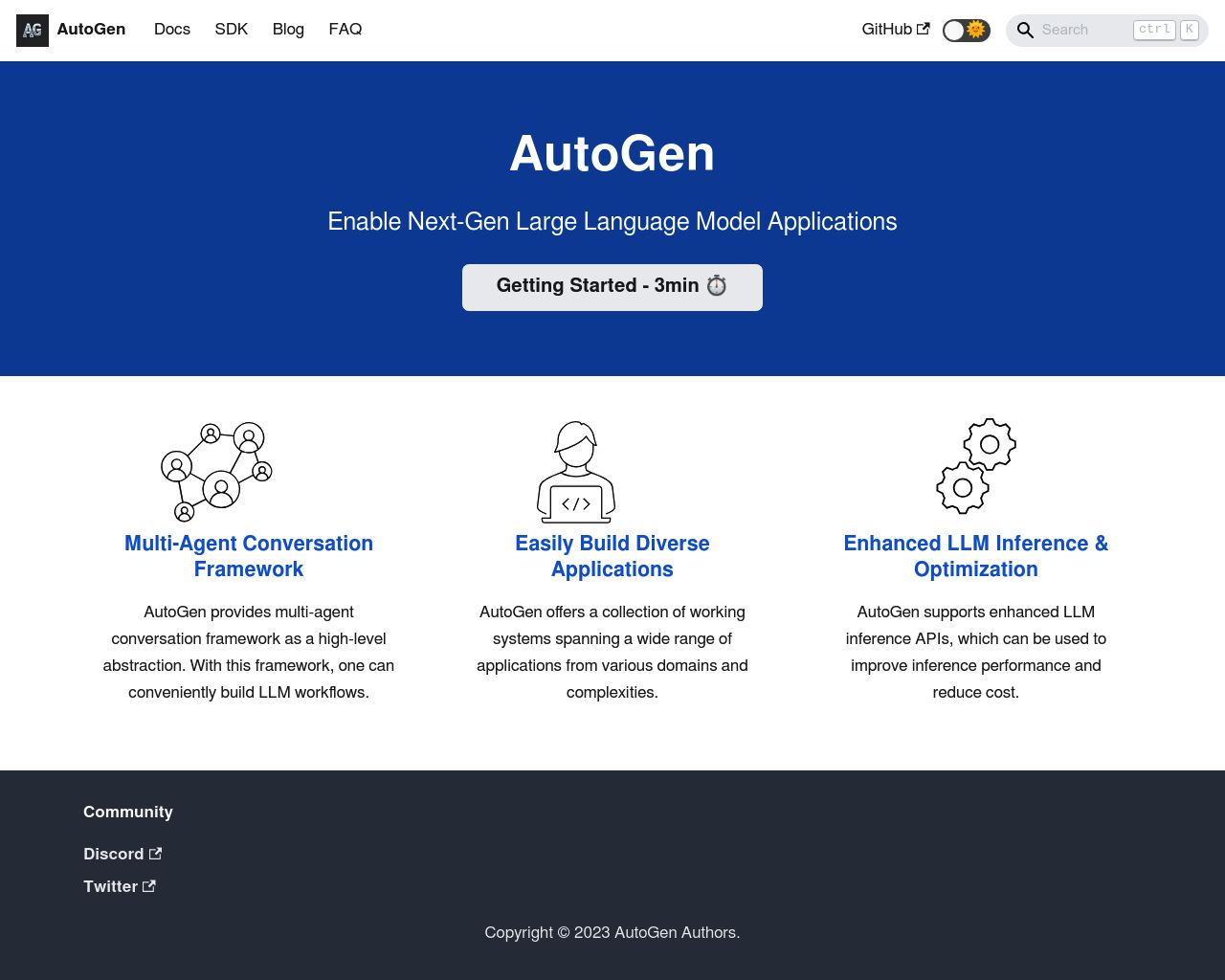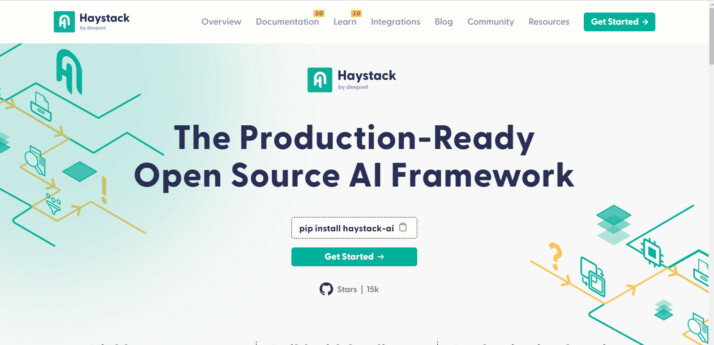AutoGen vs. Haystack: Comparing AI Development Frameworks
AI developers and business leaders face a crucial decision when selecting tools for building intelligent applications. AutoGen vs. Haystack, and SmythOS each offer unique approaches to harnessing the power of Large Language Models (LLMs) and AI agents. This comparison explores how these platforms tackle complex tasks, integrate with existing systems, and empower teams to create sophisticated AI solutions.
We’ll examine key features, development workflows, and real-world applications to help you determine which platform best aligns with your organization’s AI ambitions and technical requirements. Whether you’re a seasoned developer seeking advanced customization or a business user looking for accessible AI tools, this analysis provides the insights needed to make an informed choice in today’s competitive AI landscape.
AutoGen Overview
AutoGen empowers developers to create sophisticated AI applications through multi-agent conversations. This open-source framework enables customizable agents to interact with each other, Large Language Models (LLMs), tools, and humans to tackle complex tasks.


AutoGen’s core strength lies in its ability to facilitate autonomous multi-agent collaborations. These agents work collectively to solve problems, with or without human input, adapting to various use cases. The framework maximizes LLM performance through enhanced inference capabilities, including tuning, caching, error handling, and templating. This optimization proves crucial when working with resource-intensive models like GPT-4.
AutoGen’s core strength lies in its ability to facilitate autonomous multi-agent collaborations. These agents work collectively to solve problems, with or without human input, adapting to various use cases.
Developers benefit from AutoGen’s customizable agents, which can be tailored to specific task requirements. The framework supports both fully autonomous operations and human-in-the-loop problem-solving, offering flexibility for applications where human expertise is essential. AutoGen has demonstrated effectiveness across diverse fields, from automated task solving and code generation to continual learning and complex problem-solving in group chats.
While AutoGen offers powerful capabilities, it requires coding knowledge for setup and configuration. The framework lacks a visual builder or no-code editor, which may present a steeper learning curve for non-technical users. However, it compensates with robust debugging tools, including API call logging, essential for optimizing LLM-based systems. AutoGen also features EcoOptiGen, a cost-effective technique for tuning large language models, underscoring its commitment to enhancing LLM efficiency and effectiveness.
Haystack Overview
Haystack empowers developers to build intelligent applications using Large Language Models (LLMs) and vector search. This open-source framework excels at retrieval-augmented generation, document search, and question answering tasks.


Developers leverage Haystack to create custom search experiences and conversational chatbots. The platform’s modular architecture allows seamless integration of tools like Hugging Face Transformers, Elasticsearch, and OpenAI into flexible pipelines. This versatility enables teams to tailor AI solutions to their specific needs.
Haystack empowers developers to build intelligent applications using Large Language Models (LLMs) and vector search. This open-source framework excels at retrieval-augmented generation, document search, and question answering tasks.
Haystack shines in its ability to handle diverse data formats, including PDFs, Word documents, and plain text files. The framework’s support for multimodal agents expands its capabilities beyond text, allowing developers to work with images and other data types. Haystack’s focus on explainability and transparency aids in understanding AI decision-making processes, crucial for building trust in AI systems.
Haystack shines in its ability to handle diverse data formats… The framework’s support for multimodal agents expands its capabilities beyond text, allowing developers to work with images and other data types.
While Haystack offers powerful tools for AI development, it requires coding knowledge to fully utilize its capabilities. The lack of a visual builder or no-code editor may present a steeper learning curve for non-technical users. However, this trade-off allows for greater customization and control over the AI pipelines.
Haystack’s integration with various APIs and support for OAuth authentication enhances its utility in enterprise environments. The framework’s scalability features and compatibility with cloud services make it suitable for both small projects and large-scale deployments. Despite these strengths, Haystack does not offer built-in solutions for data lakes, webhooks, or site chat deployment, which may require additional development effort for certain use cases.
Feature Comparison
AutoGen and Haystack offer distinct approaches to AI development, each with its own strengths and limitations. AutoGen excels in facilitating multi-agent conversations, enabling autonomous collaborations between AI agents to solve complex tasks. Its enhanced Large Language Model (LLM) inference capabilities, including tuning, caching, and error handling, optimize expensive LLM utilization. AutoGen’s customizable agents adapt to specific task requirements, supporting both fully autonomous operations and human-in-the-loop problem-solving.
Haystack, on the other hand, focuses on retrieval-augmented generation, document search, and question answering. It shines in handling diverse data formats and supporting multimodal agents, expanding beyond text to work with images and other data types. Haystack’s modular architecture allows seamless integration of tools like Hugging Face Transformers and Elasticsearch into flexible pipelines. While both frameworks require coding knowledge, Haystack’s emphasis on explainability and transparency aids in understanding AI decision-making processes, crucial for building trust in AI systems.
SmythOS surpasses both in several key areas. Unlike AutoGen and Haystack, SmythOS offers a visual builder and no-code editor, significantly lowering the barrier to entry for AI development. We provide hosted vector databases and support for data lakes, features absent in both AutoGen and Haystack. Our platform also includes unique capabilities like agent work scheduling and deployment options as site chat or webhooks, addressing gaps in both competitors’ offerings. With SmythOS, we deliver a more comprehensive and user-friendly solution for AI agent development and deployment.
Feature Comparison Table
| AutoGen | Haystack | SmythOS | |
|---|---|---|---|
| CORE FEATURES | |||
| Visual Builder | ❌ | ❌ | ✅ |
| No-Code Options | ❌ | ❌ | ✅ |
| Agent Work Scheduler | ❌ | ❌ | ✅ |
| SECURITY | |||
| Constrained Alignment | ❌ | ❌ | ✅ |
| IP Control | ❌ | ❌ | ✅ |
| COMPONENTS | |||
| Zapier APIs | ✅ | ❌ | ✅ |
| Data Lakes | ❌ | ❌ | ✅ |
| DEPLOYMENT OPTIONS (EMBODIMENTS) | |||
| Staging Domains | ❌ | ❌ | ✅ |
| Production Domains | ❌ | ❌ | ✅ |
| Deploy as Scheduled Agent | ❌ | ❌ | ✅ |
| DATA LAKE SUPPORT | |||
| Hosted Vector Database | ❌ | ✅ | ✅ |
| Sitemap Crawler | ❌ | ❌ | ✅ |
| YouTube Transcript Crawler | ❌ | ❌ | ✅ |
Best Alternative to AutoGen and Haystack
SmythOS stands out as the superior alternative to AutoGen and Haystack for AI agent development and deployment. We offer a comprehensive platform that addresses the limitations of both competitors while providing unique features that streamline the AI creation process.
Our visual builder and no-code editor set SmythOS apart, making AI development accessible to users of all skill levels. Unlike AutoGen and Haystack, which require coding expertise, we empower non-technical users to create sophisticated AI agents through an intuitive drag-and-drop interface. This democratization of AI development accelerates innovation and reduces the barrier to entry for businesses looking to leverage AI technologies.
Unlike AutoGen and Haystack, which require coding expertise, we empower non-technical users to create sophisticated AI agents through an intuitive drag-and-drop interface.
SmythOS excels in deployment flexibility, offering options that surpass both AutoGen and Haystack. We provide seamless deployment as APIs, webhooks, site chats, and scheduled agents. Our platform also supports staging and production domains, ensuring a smooth transition from development to live environments. This versatility allows businesses to integrate AI agents into their existing workflows and customer-facing applications with ease.
Our agent work scheduler and hosted vector database capabilities address critical gaps in both AutoGen and Haystack’s offerings. The scheduler automates agent tasks, improving efficiency and reducing the need for manual intervention. Meanwhile, our hosted vector database simplifies data management for AI applications, a feature notably absent in AutoGen. These tools combine to create a more robust and user-friendly ecosystem for AI agent development and operation.
By choosing SmythOS, users gain access to a comprehensive suite of AI development tools that outperform both AutoGen and Haystack in key areas. We provide the ideal balance of power, flexibility, and ease of use, making SmythOS the best choice for businesses and developers looking to harness the full potential of AI agents.
Conclusion
AutoGen, Haystack, and SmythOS each bring unique strengths to AI development. AutoGen excels in multi-agent collaborations and optimizing LLM performance, while Haystack shines in retrieval-augmented generation and multimodal data handling. Both frameworks offer powerful tools but require coding expertise.
SmythOS stands out by addressing key limitations of AutoGen and Haystack. Our visual builder and no-code editor dramatically lower the entry barrier for AI development. We provide hosted vector databases and data lake support, filling gaps in both competitors’ offerings. SmythOS’s unique features like agent work scheduling and flexible deployment options as site chat or webhooks offer unparalleled versatility.
For businesses and developers seeking a comprehensive, user-friendly AI solution, SmythOS delivers the most robust package. Our platform combines the strengths of AutoGen and Haystack while adding critical features for seamless integration and deployment. Whether you’re a seasoned developer or new to AI, SmythOS empowers you to create sophisticated AI agents without extensive coding.
Get started with SmythOS today and experience the future of AI development. Our platform offers a risk-free trial with unlimited agents, allowing you to explore AI automation without commitment. Discover our diverse range of AI-powered agent templates to jumpstart your projects and revolutionize your workflow. With SmythOS, you’re not just building AI – you’re shaping the future of work.
Last updated:
Disclaimer: The information presented in this article is for general informational purposes only and is provided as is. While we strive to keep the content up-to-date and accurate, we make no representations or warranties of any kind, express or implied, about the completeness, accuracy, reliability, suitability, or availability of the information contained in this article.
Any reliance you place on such information is strictly at your own risk. We reserve the right to make additions, deletions, or modifications to the contents of this article at any time without prior notice.
In no event will we be liable for any loss or damage including without limitation, indirect or consequential loss or damage, or any loss or damage whatsoever arising from loss of data, profits, or any other loss not specified herein arising out of, or in connection with, the use of this article.
Despite our best efforts, this article may contain oversights, errors, or omissions. If you notice any inaccuracies or have concerns about the content, please report them through our content feedback form. Your input helps us maintain the quality and reliability of our information.
